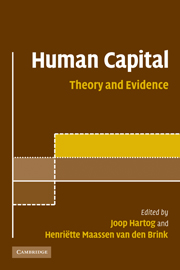Book contents
- Frontmatter
- Contents
- List of figures
- List of tables
- Notes on contributors
- Prologue
- Part I Measuring the benefits from human capital
- 1 What should you know about the private returns to education?
- 2 The social returns to education
- 3 Returns to training
- 4 Human capital and entrepreneurs
- 5 The effects of education on health
- 6 Are successful parents the secret to success?
- Part II Applying and extending the human capital model
- Part III Policy interventions
- Epilogue: some reflections on educational policies
- A note on econometrics
- Index
- References
5 - The effects of education on health
Published online by Cambridge University Press: 22 September 2009
- Frontmatter
- Contents
- List of figures
- List of tables
- Notes on contributors
- Prologue
- Part I Measuring the benefits from human capital
- 1 What should you know about the private returns to education?
- 2 The social returns to education
- 3 Returns to training
- 4 Human capital and entrepreneurs
- 5 The effects of education on health
- 6 Are successful parents the secret to success?
- Part II Applying and extending the human capital model
- Part III Policy interventions
- Epilogue: some reflections on educational policies
- A note on econometrics
- Index
- References
Summary
Introduction
Education and health are the two most important investments in human capital individuals make. Their economic value lies in the effects they have on productivity: both education and health make individuals more productive. Education and health have a considerable impact on individual well being as well. The wealth of nations is to a large extent determined by the educational attainment and the health status of their population. Compared to the abundance of empirical studies that document the individual rate of return to education (see previous chapters), we know little about the returns to investments in health.
There is evidence to support the claim that there is a positive relation between education and health. Some of this evidence is surveyed in Grossman and Kaestner (1997). This survey concludes that ‘A number of studies in the United States suggest that years of formal schooling completed is the most important correlate of good health’ (Grossman and Kaestner, 1997: 73). Not only in the United States, but also elsewhere – and in particular in developing countries – the positive association between education and health is well documented.
According to the 2003 Human Development Report, ‘Education, health, nutrition and water and sanitation complement each other, with investments in any one contributing to better outcomes in the others’ (UN, 2003: 85). The positive association between education and health can be partly attributed to differences in income between countries.
Education affects health, but investments in health and education have some common attributes as well.
- Type
- Chapter
- Information
- Human CapitalAdvances in Theory and Evidence, pp. 65 - 80Publisher: Cambridge University PressPrint publication year: 2007
References
- 3
- Cited by



